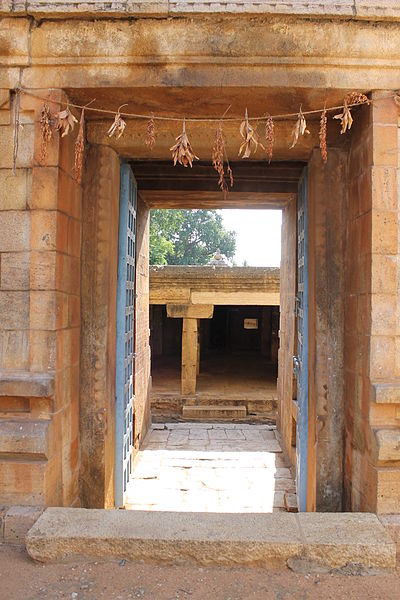Vasukisvaramudaiya Mahadeva
Temple, Visalur, Pudukottai
Visalur is a small town in Pudukkottai district
which is famous for an early Chola temple dedicated to Shiva.
The place was known with its present name, Visalur, in earlier times
as depicted from inscriptions of the Cholas and Pandyas found
in the temple. The town would have held a commendable position in the olden
days as it got the attention of the Chola rulers and their
successors, the Pandyas, as well.
A connection is found between Kudumiyanmalai and Visalur in
a Pandya inscription. The inscriptions of King Jatavarman Vira Pandya (no
360 & 361 of ARE 1906) at Kudumiyanmalai talks about transfer of
a land at Visalur, by the assembly of Visalur, to the temple of Kudumiyanmalai to
accommodate their unpaid dues.
Monuments
The only monument of interest is the Shiva temple
which is a protected monument under Archaeological
Survey of India.
Shiva Temple
The Lord of the temple is referred as Vasukisvaramudaiya
Mahadeva in the Chola inscriptions and Varadukasuramudaiya Nayanar in
the Pandya inscriptions. This temple is a nice example of the early Chola architecture.
Other similar architectural style is seen in the temples of Kaliyappatti, Panangudi and Tiruppur.
All of these early shrines were built with ektala (single storey) vimana.
Virattanesvara Temple at Tiruthani, a late Pallava creation,
may be considered as a precursor of these Chola temples.
Though temple at Tiruthani has ektala
vimana however its gajapristha (elephant back) architecture puts it
in a different league from other temples. As there is similarity between the vimana style
of late Pallava and early Chola monuments, it may be said that the Cholas got
inspiration from their predecessors however it is just a theory.
The temple is constructed with a square base on which a
square vimana rises above. Vimana has a single story above
which square griva (neck) rises. On top of this griva is a
square shikhara (cupola). The shikhara has maha nasika (big
arches) in middle on all four sides. Below these maha Nasikas, on first
and only storey of vimana, are niches carved in. These niches have Shiva as Dakshinamurti on
south, Vishnu on west and Brahma on north, confirming to the
regular arrangement of their placement.
An image of Nandi is placed on all the four
corners on this vimana story. These Nandis either face east
or west but no north and south. There are no niches on the sanctum external
walls. Each side is composed of four pilasters without any niche.
There is a probability that the temple got extended later
on with a mandapa however there is no inscription of this nature to
support this. Gopuram and the compound wall would have been an
extension from the Pandyas supported on a fact that their
inscriptions are found on Gopuram walls only. Compound wall is extended
with pillared verandah all around from inside.
A mandapa for Dakshinamurti was
constructed adjoining with the south wall of the sanctum. An image of Dakshinamurti is
now placed inside this mandapa. There are few other small mandapas constructed
for various other deities. Few loose sculptures are placed in the compound wall
verandah also. These include Jyeshta, Lakshmi and Vishnu.
Inscriptions
There are few inscriptions in and around this temple
complex. These are discussed in detail below:
No 217 of the Annual Report on Epigraphy 1940-41 –
On the north wall of the temple – Written in Tamil – dated to the twelfth
regnal year of the Chola king Rajarajakesarivarman (Rajaraja I), who destroyed
Kandalursalai, approximately in 997 CE – Records grant of lands, made tax – free,
to the temple of Vasukisvaramudaiya – Mahadeva, by the assembly of Visalur in
Misengilinadu for providing worship and offerings to the deity.
No 231 of the Inscriptions of the Pudukkottai
State – On the south wall of the temple – Written in Tamil in 11 lines –
damaged and incomplete – dated to forty-seventh regnal year of the Chola king Kulottunga
Choladeva (Kulottunga I), approximately in 1117 CE – Records provision made for
burning sandi lamp in the temple of Vasukisvaramudaiya – Nayanar in Visalur in
Misengilinadu, a sub division of Jayasingakulakala valanadu by Andan Aliyadan
of the village.
No 598 of the Inscriptions of the Pudukkottai
State – On the south wall of the gopura entrance to the temple – Written
in Tamil in 14 lines but incomplete – dated in the fourteenth regnal year of
the Pandya king Jatavarman alias Sri Vira Pandyadeva – Records a gift of land
by the residents of Puliyur in Misengilinadu, a sub division of
Jayasingakulakala – valanadu, for offerings to Varadukasuramudaiya Nayanar of
Visalur in the same nadu.
No 609 of the Inscriptions of the Pudukkottai
State – On the wall to the left of the gopura entrance to the temple –
Written in Tamil but incomplete – dated in the fourteenth regnal year of the
Pandya king Vira – Pandyadeva – mentions Misengiliyurnadu.
Connectivity
Visalur is in Pudukkottai located
very near to Kunnandarkoil. This early chola temple is located on Kunnandarkoil – Kaliyappatti – Visalur – Narthamalai route.




























